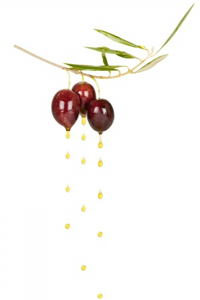Chemical Definitions
 Definitions Used with Olive Oils
Definitions Used with Olive Oils
We know that labelling on products often provides terms and definitions that we just do not connect with. Here is a listing of some definitions associated with olive oils to help you to understand the importance, how it affects the quality of the product and the benefits to your health.
In addition to the chemical characteristics, there is also a sensory taste that Olive oil tasters describe the positive attributes using the following terms:
Fruity: Having pleasant spicy fruit flavors characteristic of fresh ripe or green olives. Ripe fruit yields oils that are milder, aromatic, buttery, and floral. Green fruit yields oils that are grassy, herbaceous, bitter, and pungent. Fruitiness also varies by the variety of olive.
Bitter: Creating a mostly pleasant acrid flavor sensation on the tongue.
Pungent: Creating a peppery sensation in the mouth and throat
 Diacylglycerol (DAG) Diacylglycerol (DAG)
|
| |
| |
• |
DAG (Diacylglycerols) are natural components in all vegetable and olive oils. Olive oil has small amounts of DAGs. DAGs have been found to lower body fat when fed to subjects as the primary fat source. |
|
|
|
 Free Fatty Acids Free Fatty Acids
|
| |
| |
• |
FFA (Free Fatty Acid) ≤ 0.8% Condition of fruit prior to crushing & time between harvesting & crushing. The lower the acidity, the higher the smoke point. Extremely low acidity (0.1%) designates that the fruit was in excellent condition at harvest and picked then processed quickly (harvest/process delay) –sound fruit processed immediately = low FFA (reported g as % of Oleic acid) |
|
|
|
 Oleic Acid Oleic Acid
|
| |
| |
• |
Oleic acid is monosaturated and makes up 55-85% of olive oil. Oleic acid key to olive oil’s anti-cancer effect. No other naturally produced oil has as large an amount of monounsaturated as olive oil -mainly oleic acid. |
|
|
|
 Peroxide Peroxide
|
| |
| |
• |
Peroxides are the bi-product caused by the oxidation of olive oil. Fats and oils such as olive oil are oxidized when they come in contact with oxygen. Oxygen may exist in the bottle and dissolves in the oil especially if the seal is loose, cracked or otherwise a poor fit. The oxidation products have an unpleasant flavor and odor and may adversely affect the nutritional value of the oil
|
| • |
Essential fatty acids such as linoleic and linolenic are destroyed, and certain fat soluble vitamins disappear. Fatty acids are oxidized by one of the following: Auto-oxidation occurs in the absence of air by reactive oxygen species or "free radicals". It is temporarily prevented by the natural antioxidants in the oil that absorb these free radicals. |
| • |
When the antioxidants are used up, the oil ages quickly. Photo-oxidation occurs when the oil is exposed to natural and/or artificial light sources (including halogen lights and store lights). It causes serious deterioration of olive oil, as it can occur up to 30,000 times faster than auto-oxidation. The more rancid or oxidized the oil, the more peroxides are present. |
| • |
Measurement of the peroxides in olive oil is a very simple procedure which can done at a testing lab. High quality extra virgin olive oils have a peroxide value of less than 10meq/kg. In order to be extra virgin, olive oil must have less than 20 meq/kg. |
|
|
|
 Polyphenols (Antioxidants) Polyphenols (Antioxidants)
|
| |
| |
• |
The flavenoid polyphenols in olive oil are natural antioxidants that contribute to a bitter taste, astringency, and resistance to oxidation. They have been shown to have a host of beneficial effects from healing sunburn to lowering cholesterol, blood pressure, and risk of coronary disease.
|
| • |
Hydroxytyrosol and tyrosol are some of the many phenol compounds in olive oil. There are as many as 5 mg of polyphenols in every 10 grams of olive oil. Many other nut and seed oils have no polyphenols. The polyphenol content is determined by many factors including: |
| |
• |
Olive Varietal: Koreneiki olives, for instance have a very high level of polyphenols, while Arbequina’s content is low. The content of Frantoio olives is medium-high and that of Leccino medium |
| |
• |
Time of Picking: Oil made from green (unripe) olives has more polyphenols than oil made from ripe olives. The polyphenol concentration increases with fruit growth until the olives begin to turn purple and then begins to decrease |
| |
• |
Environmental Factors such as altitude, cultivation practices, and the amount of irrigation |
| |
• |
Extraction Conditions: Techniques used to enhance yield, such as heating the paste, adding water, and increasing malaxation time, result in a loss of polyphenols |
| |
• |
Storage Conditions: The type of containers and the length of storing are key factors in the oil’s polyphenol content. As oil sits in storage tanks or in a bottle, the polyphenols will slowly be oxidized and used up. Oils stored in stainless steel containers or dark glass bottles, in cool conditions, are much better protected against oxidation than those bottled in clear glass |
| |
|
|
|
| |
 Definitions Used with Olive Oils
Definitions Used with Olive Oils

